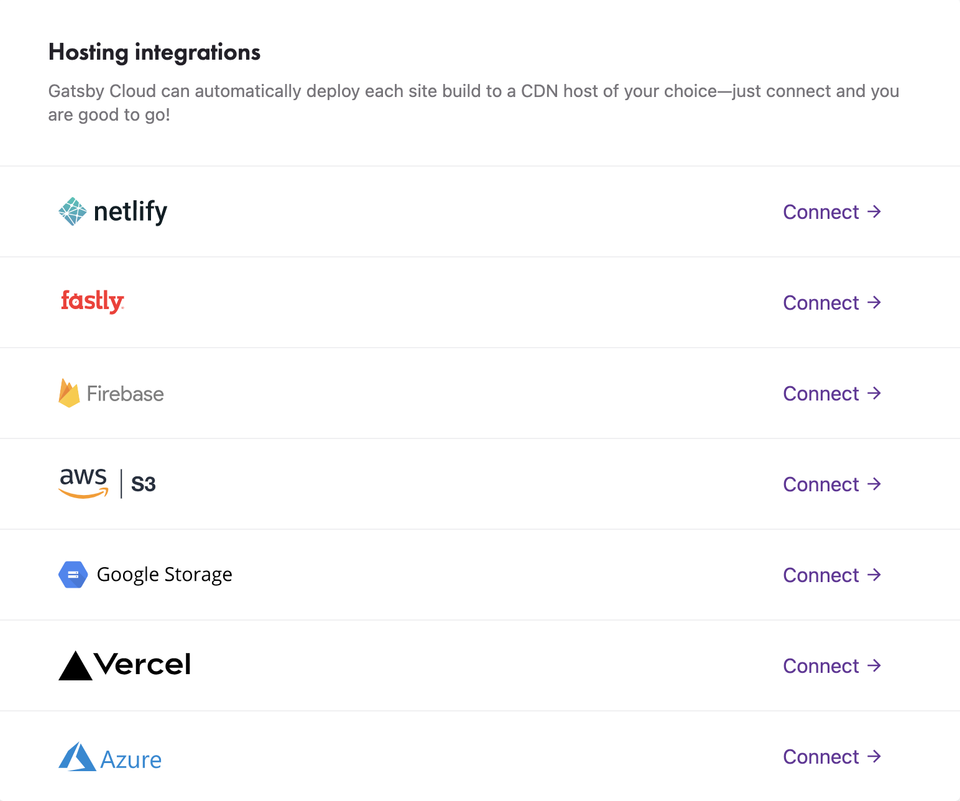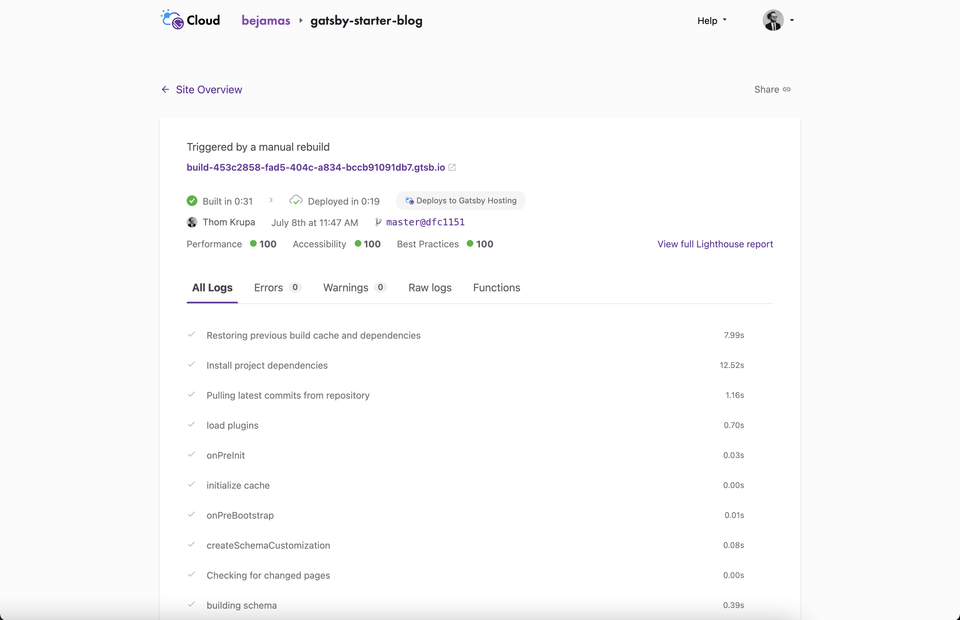Updated on 5/15/2025
Gatsby Cloud
 TK
TKThom KrupaCTO
Feature | Gatsby CloudGatsby Cloud | |
|---|---|---|
Infrastructure What runs under-the-hood. | AWS | |
Continuous Integration & Continuous Delivery (CI/CD) | ||
Continuous deployment Imagine an automatic update system for your website. This feature automatically deploys any changes you make to your code (usually from Git) to your live website. | ||
Automated builds from Git An easy integration with popular Git repository hostings like Github, GitLab and Bitbucket. | ||
Instant rollbacks to any version Easy way to promote any previous build to production without the need to revert commits or data changes. | ||
Site previews for every push New build with a unique URL for every commit and pull request. | ||
Compatible with all Static Site Generators | ||
Notifications Events triggered on successful, canceled, or failed build. | Slack, GitHub, outgoing webhook | |
Team Management Create team account and invite your teammates to the project. | ||
Custom domains Bring your own domain and connect to the project. | ||
Automatic HTTPS SSL certificate generated automatically. | ||
Rewrites & Redirects HTTP 301 or 302 redirects from one URL to another. Rewrites work similar to reverse proxy and allow to send user to different URL without modifying the original URL. | ||
Password Protection An easy way to restrict access to the website for users who don't have password. Useful if you work on a new site and want to keep it in secret. | Included in paid plan | |
Skew Protection Skew Protection ensures client and server versions stay synchronized during deployments, preventing compatibility issues. | ||
Free Tier | ||
Websites Number of projects you can have in Free Tier on one account. | Unlimited | |
Build Minutes The amount of time your build scripts can run per month. | Unlimited | |
Concurrent builds How many builds can be run at the same time? | 1 | |
Bandwidth The amount of data that is transferred to or from the CDN. | 100GB /month | |
Team Members The number of users (team members) that can be added to the CMS. | 1 | |
Build Time Per Deployment Build have to finish within the limited time. If not it will fail due to timeout. | 60 minutes | |
Build Memory Limit (in MiB) The amount of memory that is allocated by system to build process. Some operations like image processing are expensive and might require more memory. For Node.js it is max-old-space-size setting. | 1024 MiB | |
Paid Plans | ||
Max team members before switch to custom pricing | 10 | |
Git contributors have to be Team Members In order to triger build, Git contributor has to be a paid team member. | ||
Serverless | ||
Serverless Functions (API) Small pieces of code that run on-demand without managing servers, typically used for API endpoints. | JavaScript | |
Edge Functions Serverless functions that run closer to the user, reducing latency and improving performance. | ||
Background Functions Code that runs in the background on the platform to perform tasks that don't require immediate user interaction. | ||
CRON Jobs Schedule tasks to run automatically at specific times or intervals. Useful for automating repetitive website maintenance tasks. | ||
Developer Experience | ||
CLI Command Line Interface tools that allow developers to perform tasks and manage the tool via the command line. | ||
Extensions Additional plugins or add-ons that can enhance the functionality of the platform. | ||
Environment Variables Secret configuration settings for your website that change based on where it's deployed (dev, staging, production). | ||
Build Logs Track the progress and results of website builds for troubleshooting | ||
Build Canceling Ability to stop a build process that is currently running. This frees up resources and lets you make changes to your website faster by stopping builds you don't need anymore. | ||
Platform Built-in Products | ||
Analytics Tools for tracking and analyzing website traffic. | Integration with Google Analytics | |
Authentication Services for managing user logins and authentication. | N/A | |
Database Managed database services. | PostgreSQL, MySQL | |
Asset Optimizations Tools for optimizing images, CSS, JS, etc. | bundling, minifying, compressing images | |
A/B Testing Lets you test different versions of your site by directing traffic to each variant, helping you optimize user experience based on performance metrics. | ||
Form Handling Services for managing form submissions. | ||
Data Storage Solutions for storing and managing data. | ||
Push Notifications This allows your website to send real-time alerts or updates to visitors who have opted-in. | ||
Machine Learning | ||
Security & Compliance Offerings | ||
Two-factor authentication Adds an extra layer of security when logging in. | ||
Team Logs Tracks user activity within the platform for better accountability. | ||
SOC2 Service Organization Control 2 compliance for managing customer data. | ||
ISO27001 International standard for information security management. | ||
GDPR Compliance with the General Data Protection Regulation for handling personal data. | ||
Sustainability | ||
Carbon Neutral | N/A | |
Carbon-free Energy | N/A | |
Integrations | ||
Integrations Connecting your deployment platform with external services like headless content, commerce, databases, and more. | ||
Custom build-system integrations Allows you to connect your own build tools and processes with the deployment platform. | N/A | |
Support with self-hosted instances of git | N/A | |
API mesh API Mesh allows you to combine multiple APIs into a single unified API, simplifying data fetching and integration across different services and backends. | N/A | |
Deploy Preview feedback integrations Enables team members and stakeholders to comment directly on preview deployments. | N/A | |
Edge Functions integrations | N/A | |
High Performance Build Memory and CPU | N/A | |
Native Build Plugins | ||
Gatsby Cloud is a commercial platform created by Gatsby, Inc. team. It is designed for open-source Gatsby framework. Cloud started in 2019 with just a bunch of features including integrations with headless CMS and real-time preview. That was a big step forward to solve a painful Gatsby problem - long builds. They gave content editors ability to instant preview of new changes without the need to fully rebuild (which can take sometimes dozens of minutes).

Gatsby Incremental Builds
Few months after the launch, Gatsby announced Incremental Builds. If you make a change in CMS and not in the code, Incremental Build will be up to x1000 times faster than a normal one. That leads to <10 seconds build times. It's not the same as Preview which basically is a develop server running somewhere in the cloud.
Deploy to your favorite CDN
At first, Gatsby Cloud was just a CI/CD tool. They didn't offer any hosting solution. You could connect and deploy website to one of those popular CDNs:

It changed recently. If you prefer to have everything in one place, Gatsby introduced Gatsby Hosting in March 2021. You can easily add your domain and use Gatsby Cloud with Fastly under the hood. If you prefer using Netlify, Vercel or S3 you can still connect this in just one click!
Lighthouse report built-in
Gatsby Cloud runs a lighthouse test for each deployment. That's a nice way to control the performance of your builds and commits.

As you can see above, build logs are beautifully printed and grouped. That's unique for Gatsby Cloud since they can focus on just one framework.
Gatsby Functions
It seems that Cloud roadmap is tied with Gatsby the framework roadmap. This is similar strategy to what Vercel does with Next.js. By having control on both software and infrastructure Gatsby team can improve developer experience and release features that are supported on their Cloud on the release day. A small vendor lock-in is the price you need to pay in order to have top-notch UX.
Conclusion
Gatsby Cloud is probably the best way to run Gatsby projects. Especially if you struggle with long build times or want to take advantage of Gatsby Previews. It's not designed to work with other frameworks, so if Gatsby is not your jam, take a look on other options in our Discovery Hub.
Use cases
- Gatsby websites and apps.
Pros & Cons
| Gatsby Cloud | vs Pros | vs Cons |
|---|---|---|
Optimized for fast Gatsby builds. | ||
Preview content in seconds. | ||
Integration with multiple headless CMSes. | ||
Easy deploy to third-party CDNs (Netlify, Fastly, Firebase, AWS S3, Google Storage Vercel, Azure). | ||
Support for Serverless Gatsby Functions. |
 AWS Amplify
AWS Amplify Azure Static Web Apps
Azure Static Web Apps Begin
Begin Cloudflare Pages
Cloudflare Pages Deno Deploy
Deno Deploy Digital Ocean App Platform
Digital Ocean App Platform Firebase
Firebase GitHub Pages
GitHub Pages Heroku
Heroku Kinsta
Kinsta Layer0
Layer0 Netlify
Netlify Render
Render Vercel
Vercel